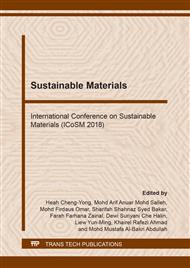p.237
p.243
p.251
p.258
p.264
p.270
p.277
p.284
p.294
Effect of Blend Ratio on the Mechanical and Thermal Properties of Polyurethane/Silicone Rubber Conductive Material
Abstract:
This work reports on mechanical and thermal properties of a novel polymer blend. Blends were prepared by mixing silicone rubber with diphenyl – 4,4 – dissocyanate in different ratios. Graphene nanoplatelets was added as conductive filler to improve the electrical conductivity of the blends. The mechanical properties, including tensile and tear performances were measured by a material testing system. The thermal stability of the blends was measured by thermogravimetric analysis. Incorporation 20 vol.% of silicone rubber can help to improve the thermal stability of the blend, meanwhile optimum mechanical properties of the blends is achieved.
Info:
Periodical:
Pages:
264-269
Citation:
Online since:
August 2018
Authors:
Keywords:
Price:
Сopyright:
© 2018 Trans Tech Publications Ltd. All Rights Reserved
Share:
Citation:


